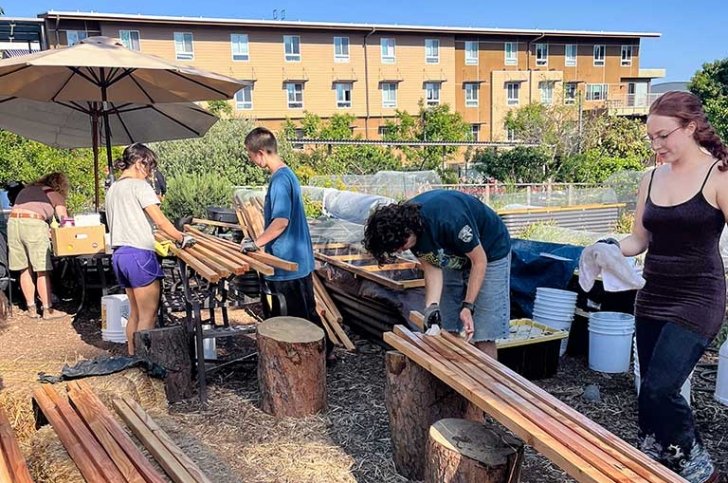Pitzer Offers First Inside-Out Spanish Class in the U.S.
Incarcerated “inside” students and “outside” students from The Claremont Colleges redefine Latinx identity, power, and the Spanish language on their terms.

Stryder Rodenberg ’25 would always remember the first words he heard in prison on his way to class. As he and other students passed through security at the California Rehabilitation Center in Norco, Calif., a prison guard remarked, “Here come the libs.”
What, Rodenberg wondered, did it mean to talk about liberation in a prison education class? He and his classmates embarked on an answer with the first Inside-Out course conducted in Spanish in the U.S.
Inside-Out creates a shared learning environment for “inside” incarcerated students and “outside” students from The Claremont Colleges. Pitzer Professor Paula Gutierrez was excited to teach her first Inside-Out class, Latinx Identity: Language and Power. According to the catalog description, her Spanish course “explores the complex relations between language, race/ethnicity, and power in the construction of identity.”
Reclaiming bilingualism, identity, and culture
Gutierrez’s class included many heritage speakers. Many of her students faced discrimination for using Spanish growing up, and she wanted a forum to reclaim ownership of the language.
“Spanish is a minoritized language, even in California, where so many people speak it,” said Gutierrez. “It is important for speakers of the language to rebuild their identities related to the language in a more positive light.”
Ryan C. ’25 found the class transformational. He is a member of the fourth cohort of Pitzer’s Inside-Out Pathway-to-BA program, which enables students to obtain a bachelor’s degree while incarcerated. He was released shortly before Commencement.
“I have learned so much about my culture that my own family hasn’t been able to teach me!” he said.
Growing up Mexican American in Southern California, he never fully identified as white (on his father’s side) or Mexican (on his mother’s side). He sometimes visited family in Mexico and learned some of his family history, but he experienced gaps in understanding his identity. He came to embrace his own Mexican American and Chicano culture as distinct from mainstream Mexican culture. Gutierrez’s class introduced Ryan to more experiences like his.
“Reading stories of others who identify as Mexican American or Chicano and who have discussed some of the issues that I have encountered growing up has deepened my sense of pride of who I am, and the beautiful culture I come from,” said Ryan.
“The Spanish language is a resource, it is the gossamer of a culture that does not care if you forget it but rewards you if you do,” said Jessie G., another “inside” student who was in the class but is not enrolled in the Pathway-to-BA program. “Gossamer because it is a dying, fleeting, yet durable artifact. So light, it will catch in the wind, but then it [starts] anew in a new land just like my Mexican ancestors, still unsung for their brave quest in search of better lives.”
Rodenberg said the class helped him think more deeply about how bilingualism is viewed based on race, gender, and other forms of identity. He recognized how his privilege afforded a positive bilingual experience growing up.
“One of my classmates mentioned the saying ‘Classy if you’re rich, trashy if you’re poor,’” said Rodenberg. “In my experience being bilingual and white, well educated, and of means, speaking a second language is always celebrated.”
“Inside” and “outside” students brought diverse views based on whether they were heritage or non-heritage speakers or came from privileged or marginalized backgrounds. Yet they found commonality by speaking Spanish in community.
“Everyone speaks a language, and we all relate to how the language we’re speaking puts us in certain structures of power and certain positions,” said Gutierrez.
A personal dimension to learning liberal arts
A signature part of an Inside-Out class is how “inside” students enrich discussions of theory and literature by tying them to their real-life experiences. Rodenberg saw this in action when the class read The House on Mango Street by Sandra Cisneros. Just 15 pages sparked an hour and a half of discussion as the students shared their stories.
“‘Inside’ students tend to bring a deeply personal, relational way of engaging with literature, whereas the ‘outside’ students traditionally have a more analytical way of engaging,” said Rodenberg. “I could totally see that dynamic in Inside-Out where people talked about how it related to their lives. It was a really powerful moment that brought us together as a class.”
Rodenberg double-majored in Spanish and organizational studies, and he devoted his Spanish thesis to the Inside-Out class experience. Rodenberg noted how “inside” students who only spoke Spanish had less access to education that could reduce their sentence. He wanted to delve into the complexities of freedom, academics, and language by hearing from people’s direct experiences in Inside-Out.
“If liberal arts is this academic project that’s, in part, focused on equipping students to think about liberty, how do you do that in a prison, which definitionally restricts liberty?” said Rodenberg.
Rodenberg decided a traditional, argumentative paper couldn’t capture what he wanted.
“How can I replicate the magic and dynamics that occur in the Inside-Out classroom?” said Rodenberg. “The point of this thesis is to preserve humanity, dignity, and to think about liberty. I realized the best way to do that is through literature.”
Rodenberg’s thesis tells a fictionalized account of a classroom experience that teases out the differences between the liberal arts and Inside-Out. Rodenberg based the story on interactions with classmates and interviews with Inside-Out alumni and faculty.
“I’m drawn to creative works that expose me to new ideas, ask me to think a different way, and speak to a truth or bring my attention to a truth I hadn’t thought about in a particular way before,” said Rodenberg. “My hope is that if you were to read this, you’d have a sense of what it’s like to have a class in a prison. Reading it, it feels very normal because it feels very normal in the class. You forget you’re inside a prison.”
Community-based Spanish education
What stood out to Gutierrez about teaching her first Inside-Out class was students’ intense motivation and engagement.
“The ‘inside’ students admire the ‘outside’ students, and the ‘outside’ students admire the ‘inside’ students,” said Gutierrez. “That makes everyone eager to listen to others more and learn more about them. It makes for positive community building.”
Chris F. ’26, an “inside” student who recently joined Pitzer’s fifth cohort of Inside-Out Pathway-to-BA, appreciated how people in class authentically interacted with each other.
“Our professor is not telling us what to believe or how to think but instead presenting information to get the class to discuss and work through conflicts, issues, and conversations most are not having,” said Chris. “The class engagement has been organic and fulfilling.”
Community is the center of not only Inside-Out but also Gutierrez’s field group of Modern Languages, Literatures, and Cultures (MLLC) at Pitzer. The MLLC field group emphasizes language learning through relationships.
“Our languages programs are community-based and community-engaged,” said Gutierrez. “We try to connect our students to communities of speakers on campus, around campus, and in the world.”
The people-powered mission proved truer than ever in Gutierrez’s Inside-Out class. Together, her students gained a deeper appreciation for each other and the Spanish language.
“Language isn’t just words—it’s a weapon,” said “inside” student Alejandro M. “Everything we speak burns the stories they tried to bury. This program? Not about playing by their rules. It’s about breaking their boxes, rewriting what “belonging” means, and speaking in ways they can’t mute. No apologies. No filters. Just our voices—loud, messy, and uncontainable.”
Header Photo (L-R): Ryan C. '25 and Styder Rodenberg '25 at Commencement 2025. Photo by Isabel Amezquita.
News Information
Published
Author
Bridgette Ramirez
Organization
- Justice Education Center at the Claremont Colleges
- Communications


